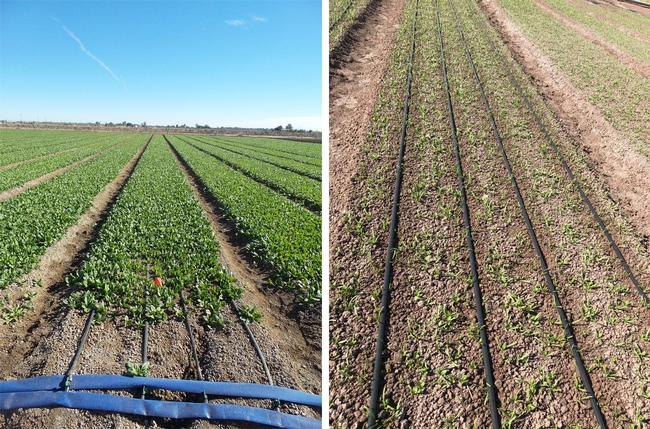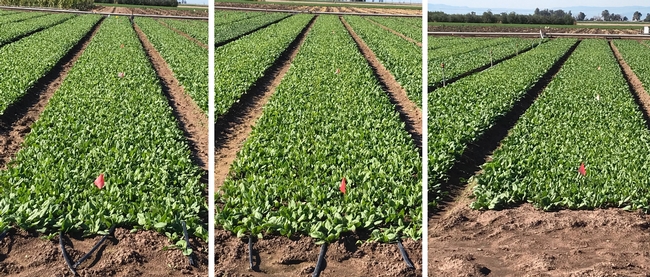Spinach is a fast-maturing, cool-season vegetable crop. In California, most conventional and organic spinach fields are irrigated by sprinkler irrigation. However, sprinkler irrigation could contribute to the speed and severity of downy mildew epidemics, as the most important disease in spinach, within a field when other conditions such as temperature are favorable.
Although fungicides are available for the control of downy mildew in conventional production systems, products with similar efficacy are not available for organic spinach. Adapting drip irrigation for high-density spinach plantings may be a possible solution to reduce yield losses from downy mildew and enhance resource-use efficiency in organic spinach production.
Currently, drip irrigation is not used for producing spinach in California, and there is a lack of information on the viability of this technology and optimal practices for irrigating spinach with drips. We initiated a study funded by the California Leafy Greens Research Board to evaluate the viability of drip irrigation for organic spinach production in California. The project was particularly aimed at understanding the system design to successfully produce spinach, and to conduct a preliminary assessment on the impact of drip irrigation on the management of spinach downy mildew.
So far, the experiment has been conducted over two crop seasons at the University of California Desert Research and Extension Center located in the low desert of California. Various combinations of dripline spacings and installation depths were assessed and compared with sprinkler irrigation as control treatment. Comprehensive data collection was carried out to fully understand the differences between the irrigation treatments.
Statistical analysis indicated very strong evidence for an overall effect of the irrigation system on spinach fresh yields, while the number of drip lines in bed had a significant impact on the shoot biomass yield. The developed canopy crop curves revealed that the leaf density of drip irrigation treatments was slightly behind (1–4 days, depending on the irrigation treatment and crop season) that of the sprinkler irrigation treatment in time.
The results also demonstrated an overall effect of irrigation treatment on downy mildew, in which downy mildew incidence was lower (approximately 5 times lower) in plots irrigated by drip following emergence when compared to the sprinkler. The likely mechanism causing this effect was a reduction under drip irrigation of leaf wetness, which is critical for infection and sporulation by the downy mildew pathogen.
The probe output of the leaf wetness sensors for a period of 12-day showed that sprinkler-irrigated crop canopies remained wet 24.3% times longer than the crop canopy irrigated by drip system. The preliminary findings: drip irrigation has the potential to be used to produce organic spinach, conserve water, enhance the efficiency of water use, and manage downy mildew, but further work is required to optimize system design, irrigation and nitrogen management practices, as well as strategies to maintain productivity and economic viability of utilizing drip irrigation for spinach. Assessing drip irrigation for the entire crop season, including germination, could be another research interest since spinach is a short-season crop and combining the sprinkler for crop germination and drip for such a short period might cause some practical issues. We will continue investigating these issues through this ongoing project in the next two years.
For more information about the results of this project so far, you may view the recently published research article in MDPI, Research Advances in Adopting Drip Irrigation for California Organic Spinach: Preliminary Findings
This article was also published in the August-September 2019 issue of Organic Farmer magazine.


